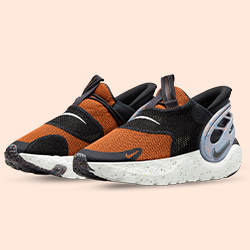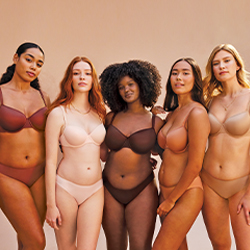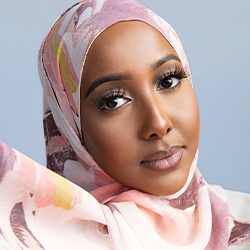As an eight-year-old child on the heavier side, I often had to opt for clothes made for 12-year-olds. When I was young, this didn’t really faze me—in fact, I even thought it was cool to wear “big girl” attire. But as my teen years hit, I felt increasingly self-conscious and excluded by the lack of options for someone my size.
I’d walk into a store and see walls of beautiful dresses and skinny jeans, but even the largest sizes offered were a stretch (pardon the bad pun). And when stores did carry bigger sizes, those beautiful dresses were nowhere to be seen—only garments that were frumpy or unflattering. If the clothing was similar, it was somehow more expensive. So yeah, you can try to look like the thinner girls, but it’ll cost ya for that extra fabric. A great way to make a girl feel special and included, right?
But the older I got, the more I realized that there was nothing wrong with me—those clothes just weren’t made for me.
Of course, this lack of inclusion didn’t stop (or even start) with big sizes. Fashion for differently abled people, religious groups, nonbinary individuals and people who weren’t thin, young and white were practically nonexistent. Today, this landscape is being refashioned (I’m sorry, I’ll stop soon). Indeed, a hefty 71% of respondents to a survey by Rush Order Tees—a custom apparel online platform—feel that the stores they frequent today are inclusive, and 80% believe the fashion industry is increasingly making an effort to be more inclusive.
These are promising numbers and a great sign for the future of fashion, but there’s still a ways to go. Notably, those with disabilities had the most trouble getting clothes made with them in mind, with 34% stating they couldn’t find clothes that expressed their identity.
And inclusion isn’t just slapping a plus-sized line on your website or hiring one model of color; it’s a process that involves learning about and listening to diverse communities. Here are five brands that are doing that work and celebrating inclusivity with both their apparel and mission statements.

There are few things on this planet that can make me speechless (just ask my husband …), but when I stumbled upon dresses by JessaKae on Instagram, I felt my heart skip a beat. Yes, they’re that pretty, and boy-oh-boy are they size inclusive.
Founded by husband-and-wife duo Jordan and JessaKae Maddocks, the brand carries sizes XXS to 5XL. That’s 11 sizes of “easy and romantic” dresses for the modern girl, and JessaKae says they’re working on expanding to 6XL, too.
“No matter their shape or size, women should be able to find comfortable, beautiful clothes,” she says. “We have no ‘plus size’ sections or collections because our dresses are for everybody. Fashion doesn’t need to be divided.”
Unlike many other brands that carry big sizes, you don’t have to use your imagination to deduce how the dress will look on a body like yours. Hover over any look on their website and poof, the image changes right before your eyes: a slim model becomes a plus-size model with the wave of your mouse.
Why is this important? From experience, it’s difficult to visualize the way something will fit my body when I see it on someone much smaller than me—where it’s figure hugging on them, will it squish me? Where it’s loose, will I fill it up too much? It’s also nice to see how colors work on different skin tones (the brand makes a conscious effort to feature an array of models of color in all their collections). “We aim for at least half of our models in collection shoots to be POC and include as many ethnicities as possible during campaign shoots,” JessaKae adds.
To top it off, JessaKae’s “Mommy and Me” collection caters to, you guessed it, mothers and their little ones. Typically underserved in the fashion world, these matching sets allow moms to dress themselves and their kids in the latest styles—with “bump-friendly” and “nursing-friendly” outfits to boot that cater to all stages of motherhood.
Plus, prices range from $100-$250, making the brand an affordable option for many.
Nike FlyEase

The Rush Order Tees survey found that only 21% of respondents saw models with disabilities among the brands they shop. Sportswear giant Nike came second to Adidas among the most inclusive brands overall, the same survey shows. Nike’s FlyEase shoes and clothing serve as a key example.
Developed specifically for people with disabilities, this clothing line aims to make sports accessible to everyone. Using input and insights from the disabled community, the FlyEase items are designed to be quick and easy to get into and out of.
The shoes, for example, provide step-in entry, cushioned support, a wider fit for more space, zippers or no-tie lacing you can operate with one hand and midfoot webbing for security.
Starting at around $55 for kids’ sizes and $200 for adult designs, the shoes are in line with other Nike products.

For too long, the underwear and lingerie industry catered more to the male gaze than to the women wearing the products. And that’s something Heidi Zak, co-founder and CEO of ThirdLove, wanted to address with her brand.
ThirdLove is well known for being size-inclusive—with wireless bras ranging from XS-3X, bra band sizes from 32-44 and cup sizes from A-H—and diverse. Here, however, we want to focus on their dedication to redefining what a “nude” shade actually means.
Historically, nude simply meant “beige.” But using a data-driven approach, ThirdLove created its New Nakeds collection, which has five different “nude” shades—soft pink, taupe, mocha, sienna and espresso—that can be worn as neutrals against a variety of skin tones. ThirdLove’s most popular bra costs about $68, which is pretty typical for a solid, dependable holder for the twins.
Need more reason to love the brand? The underwear conglomerate has launched a small business mentorship program, The TL Effect, for women-of-color entrepreneurs (though “women” here includes trans women, genderqueer women and non-binary folks). The three-month program also provides workspaces and a $20,000 cash grant.

In high school, Hilal Ibrahim realized that modest and religious fashion was hard to find and seldom included in mainstream brands. Stylish hijabs, the head coverings worn by women of Islamic faith, were especially difficult to come by and there was often a stigma that women can’t be pretty wearing one.
That didn’t sit well with Ibrahim, so in 2017 she launched Henna & Hijabs with the goal of addressing the “lack of access Muslim women face in finding sustainable and fashionable hijabs,” Ibrahim says.
Her elegant head scarves come in a variety of fabrics (including silk and chiffon), colors and designs to truly represent and empower the modern Muslim woman. They range in price from $45 to $95.
Along with their fashion line, Henna & Hijabs also makes garments for Muslim women in the health care industry. Knowing it was difficult for them to find suitable apparel for their jobs (and materials allowed in such environments), Henna & Hijabs created the first health care hijab in 2018. During the pandemic, Henna & Hijabs donated over 700 hijabs to doctors and nurses in Minnesota, where the company is based.
“It is my hope that by creating medical apparel that is culturally inclusive for Muslim women—both patients and health care workers—we will change health care around the world for the better,” Ibrahim adds.
Henna & Hijabs promises to only use ethically sourced materials, treat their workers with dignity and be inclusive of all. And thanks to a partnership with Nordstrom, these hijabs are the first the luxury department store chain has ever carried.

And now, let’s take gender out of fashion altogether. Los Angeles-based Big Bud Press specializes in unisex, everyday garments and goods that, as co-founder Lacey Micallef says, represents “how I saw the world and how I felt companies should be run.”
Their colorful and vibrant jumpsuits, shirts, pants and more will be stuck in your mind long after you leave the online store—the Cookbook 2.0 Print Jumpsuit, for example, will not let me sleep and thus there is no recourse but to buy it immediately. Some pieces are airbrushed by hand and so are totally unique: no two Summer Dream Airbrush Work Pants are the same, for instance, and are priced at $135 a pair.
Every clothing item is modeled by people of varying sizes and gender presentations to give you an in-depth look at each body type. “We live in such a vibrant and diverse society—to do anything but represent that is denying reality,” Micallef says. “It’s important for our customers to be represented in our photos because they are who wear our clothing.”
Aside from not focusing on gender whatsoever in building their brand, Big Bud Press has sizes that range from XXS to 6XL, a truly impressive scale, and their models are incredibly diverse.
Dedicated to ethical and local manufacturing practices, the company is also sweatshop free and plans for all of their fabric to be domestically sourced by the end of this year. What’s not to love?
Kelly Meehan Brown is Millie’s editor and an Irish expat who has been covering all things at the intersection of money and fun for the past five years. She currently lives in New York City with her husband and one-eyed black cat Thackery.
Millie content is licensed from Dotdash Meredith, publisher of Millie, Real Simple, InStyle, Investopedia, The Balance and more.




